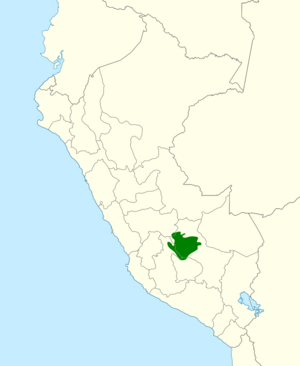Inca wren facts for kids
Quick facts for kids Inca wren |
|
|---|---|
| Conservation status | |
| Scientific classification | |
| Genus: |
Pheugopedius
|
| Species: |
eisenmanni
|
 |
|
| Synonyms | |
|
Thryothorus eisenmanni |
|
The Inca wren (Pheugopedius eisenmanni) is a small bird that belongs to the wren family. This special bird lives only in Peru, which means it is endemic to that country.
Contents
About the Inca Wren
Discovery of the Bird
The Inca wren is a unique bird. It is known as a monotypic species. This means it is the only member of its group.
It's quite interesting that experts did not find this bird until the 1960s. They did not officially describe it until 1985. This is surprising because people often see it near Machu Picchu.
What Does It Look Like?
The Inca wren is about 14.5 to 15.5 cm (5.7 to 6.1 in) long. Males weigh about 22.0 to 27.0 g (0.78 to 0.95 oz). Females are a bit lighter, weighing 19.0 to 23.0 g (0.67 to 0.81 oz).
The adult male has a dark black top of its head and neck. It has a wide white stripe above its eye. Its face has black and white stripes. Its back and shoulders are a bright reddish-brown color. The tail is also reddish-brown with dark bars. The male's throat is white. Its chest and belly are white with bold black stripes. Its sides are a dull yellowish-brown.
The adult female looks a little different. The top of her head is charcoal gray. She only has stripes on her chest, not her whole belly. Her tail also has fewer bars than the male's.
Young Inca wrens are duller in color. They have a brown head. Their undersides are a light grayish-brown with no stripes.
Where Do They Live?
The Inca wren lives only in a small part of Peru. This area is in the Department of Cuzco. It is on the eastern side of the Andes Mountains. These birds live at high elevations. They can be found between 1,700 and 3,350 m (5,580 and 10,990 ft) above sea level.
They prefer to live in humid montane forests. They like the lower and middle parts of these forests. They also live along the edges of the forest. They especially like thick areas of Chusquea bamboo plants.
Inca Wren Behavior
What Do They Eat?
The Inca wren mainly eats insects. However, scientists do not know many details about their exact diet.
They look for food close to the ground. They search in bamboo and other thick plants. They usually forage in pairs. Sometimes, they can be seen in groups of up to six birds. They rarely join other types of birds when looking for food.
Reproduction and Life Cycle
Scientists do not know much about how Inca wrens reproduce. They have seen young birds that have just left the nest in May. This suggests that breeding happens before then.
How Do They Communicate?
Male and female Inca wrens sing together. They create a rich, varied song. It sounds like a series of whistled tunes. One of their calls sounds like a rich tchp or tchp-er. Sometimes, they make this sound in a fast series.
Conservation Status
The IUCN (International Union for Conservation of Nature) has checked on the Inca wren. They have listed it as a species of "Least Concern." This means it is not currently at risk of disappearing.
Even though it lives in a small area, its population seems to be growing. This bird can even benefit from some human activities. For example, a small amount of clearing for farming or building roads might help them locally.


